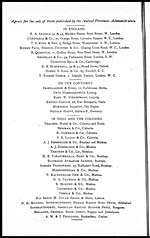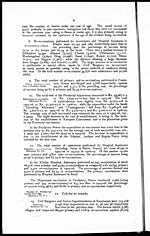Medicine - Vaccination > 1868-1929 - Report on the vaccine operations in the Central Provinces > Vaccine operations Central Provinces 1900-1911 > 1906-1907 - Notes on vaccination in the Central Provinces for the season 1906-07
(275) [Page 1]
Download files
Individual page:
Thumbnail gallery: Grid view | List view
![(5) [Page 1] -](https://deriv.nls.uk/dcn17/9152/91521094.17.jpg)
NOTES ON VACCINATION IN THE CENTRAL
PROVINCES AND BERAR FOR THE
SEASON 1906-07.
Population and area in which
vaccination work was per-
formed .
The population and area in which vaccination work
was carried on were 13,566,898 persons and 129,033
square miles respectively.
Vaccination establishment.
2. The establishment of Nagpur District has been increased by two vacci-
nators owing to the inclusion of the vaccinators working
in the Kamptee Cantonment, while the establishment of
Chhindwara was reduced by one vaccinator.
In the Feudatory States two vaccinators of Udaipur, 7 of Sirguja, and
5 of Jashpur States have been included, while there was a decrease of one
vaccinator in Bastar State. Thus during the year under report there was an
increase of one vaccinator in the Khalsa and of 13 in the Feudatory States.
The Vaccination Establishment in the province is about to be reorganized in
consequence of the recent orders of the Government of India in their resolution
No. 190-202 (Home Department) of 27th November 1906
Total number of operations
performed in the Khalsa and
Feudatory States.
(Statement No. I.)
3. Work in the Department was very materially interfered with by the
prevalence of plague The total number of vaccine
operations, primary and secondary (including Dispensary
vancination), performed throughout the province, was
617,381 or 8,757 less than in the previous year. Of this
total 525,977 were primary and 91,404 re-vaccinations against 551,140 and 74,998
respectively in 1905-06, being a decrease of 25,163 in the former and an increase
of 16,406 in the latter, the percentage of success in primary being 98.56 and in
re-vaccinations 75.38. The average number of operations performed by each
vaccinator was 2,058 or 31 fewer than in 1905-06, while the number of persons
successfully vaccinated per 1,000 of population was 2.77 less than in the previous
year.
Total number of operations
performed in the Khalsa.
4. The total number vaccinated in the Khalsa (including Dispensary vacci-
nation) numbered 544,575 or 14,868 less than in 1905-06.
Of this decrease 12,626 occurred in Berar. The percent-
age of success in primary vaccinations was 98.68 and in re-vaccinations 74.71.
Total number of operations
performed by Provincial vacci-
nators.
5. The total number of operations performed by vaccinators in the Khalsa
was 523,532 against 534,277 in 1905-06, being a decrease
of 28,492 in primary and an increase of 17,747 in re-vacci-
nations. The average number of persons vaccinated by
each vaccinator was 2,069.
Increase or decrease in pri-
mary vaccinations in different
districts.
6. Compared with the figures of the previous year there was a decrease of
28,492 in primary operations during the year. The
decrease was most marked in Jubbulpore (5,651), Wardha
(4,984),Yeotmal (4,191), Bhandara (3,169), Amraoti
(3,059), Chanda (2,076), Damoh (1,681), Narsinghpur (1,563), and Saugor
(1,328). The great falling off is chiefly and I think correctly attributed to (1) the
prevalence of plague and cholera epidemics ; (2) the withdrawal of vaccinators from
their duty for employment on special epidemic duty on plague and cholera ; (3)
sickness and mortality among vaccinators in common with the rest of the popula-
tion. The districts which show increase in primary vaccinations were Buldana
(1,013), Drug (793), Seoni (778), Raipur (456), Nagpur (445) and Chhindwara
(141).
7. Three hundred and fifty-seven thousand seven hundred and eight-two
children under one year of age were returned as available for vaccination,
while 363,259 under one year were recorded as successfully vaccinated.
The former figure was obtained by deducting from the total births in the
Set display mode to: Large image | Zoom image | Transcription
Images and transcriptions on this page, including medium image downloads, may be used under the Creative Commons Attribution 4.0 International Licence unless otherwise stated. ![]()
| Permanent URL | https://digital.nls.uk/91521092 |
|---|
| Attribution and copyright: |
|
|---|




